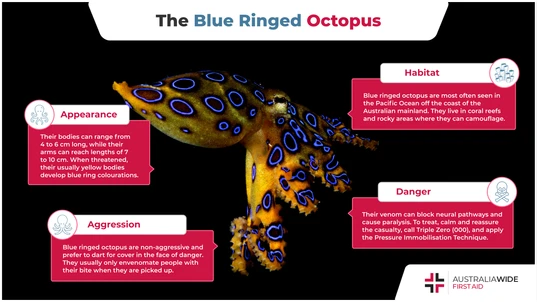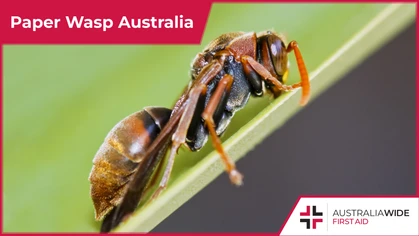Deadly Marine Life: The Blue Ringed Octopus

Bites and Stings

Blue ringed octopuses are most often seen in the Pacific Ocean off the coast of the Australian mainland. Despite their miniscule size, Blue ringed octopuses are some of the deadliest creatures in the water, and their neurotoxic venom can and has killed people.
The bite from a blue ringed octopus is painless and potentially lethal. Prompt and appropriate application of first aid may prevent serious injury and death. The blue ringed octopus is a small species that lives off the Australian coast in the Pacific Ocean. Although they exist off the coast year-round, they are more often encountered in summer, when humans and octopuses seek out shallow tide pools. Summer is the mating season for the blue ringed octopus, so they may be more present. Despite their small size, the blue ringed octopus is highly venomous. They produce a neurotoxin called tetrodotoxin and distribute it through their bite. The Ocean Conservancy says that each octopus holds enough venom to kill 26 humans. Although bites from this small species are rare, knowing how to identify and treat them may improve survival.What is the Blue Ringed Octopus
The blue ringed octopus belongs to a category of cephalopods. Their name comes from the iridescent blue colouration they generate on the surface of their body when threatened. According to the Australian Institute of Marine Science, the blue ringed octopus is classified as follows: phylum Mollusca; class Cephalopoda; order Octopoda; family Octopodidae; and genus Hapalochlaena. According to the Natural History Museum, there are four subspecies of blue ringed octopuses: the greater blue ringed octopus, the southern blue ringed octopus, the blue lined octopus, and a fourth rare subspecies known by its scientific name as Hapalochlaena nierstraszi.Distribution and Habitat
Although they are most often seen in the Pacific Ocean off the coast of the Australian mainland, their presence has also been documented in the Indian Ocean and off the coast of Tasmania. They live on coral reefs and in rocky areas where they can safely camouflage and hide from predators. Sometimes, particularly during mating periods, they are found in shallow areas, but they can also be found at great depths. They primarily eat crustaceans and small fish, paralysing their prey using venom delivered via a bite.Description
The two most encountered species in Australia are the southern blue ringed octopus and the blue lined octopus. Their key identifying characteristic is the blue ring colouration on their bodies. When in a calm, non-threatened state, the octopuses can appear yellow, brown, and green. The southern blue ringed octopus is the largest of the four identified subspecies at approximately 22 centimetres long. It can display 40-50 blue rings and is found at depths of up to 50 metres. The blue lined octopus is slightly smaller than the southern blue ringed octopus and has only been found at depths of 20 meters. It is characterised by blue, iridescent lines on its mantle.
Commonly found on the soft, sandy bottoms of shallow tide pools off the Australian coast, the blue ringed octopus only displays its tell-tale iridescent blue rings when it feels threatened.
Venom
When attacking prey or threatened, the blue ringed octopus releases venom through its bite, which is usually painless. The toxin it secretes is a neurotoxin called tetrodotoxin. It works by blocking neural pathways causing paralysis of musculature. The number of documented deaths from the bite from blue ringed octopuses varies by source. The Ocean Conservancy reports that there have been no deaths. Still, other sources, like the Australian Institute of Marine Science and the Natural History Museum, indicate that there have been several human deaths from this species. What is evident is that the venom it possesses is highly lethal for both humans and its prey. Any encounter with this species should be taken seriously.First Aid
Symptoms after an encounter with a blue ringed octopus will be evident within minutes and increase rapidly in severity: first, nausea, vomiting, and numbness. Then, loss of motor skills, vision loss, and respiratory failure. Paralysis, respiratory failure, and death can occur 30 minutes after a bite. Treatment includes:- Reassure the casualty and keep them calm and at rest
- Call Triple Zero (000) to report the emergency and request an ambulance
- Apply pressure immobilisation technique (PIT):
If bitten on a limb, ASAP, apply a wide heavy elastic bandage (10-15 cm wide) over the bite site
Bandage should be firm and tight. To test, you should not be able to slide a finger between the bandage and the skin easily
Apply a second heavy elastic bandage starting from the fingers or toes and winding as far up the limb as possible. Consistent coverage (overlapping half over half) and consistent pressure (firm but not cutting circulation) are key to an effective PIT
Immobilise the joint with a sling or splint so that movement is restricted
Improvise as needed for supply limitations - Follow Basic Life Support practices (DRSABCD) if the casualty becomes unresponsive and is not breathing normally:
D: Dangers?
R: Responsive?
S: Send for help
A: Open Airway
B: Normal Breathing?
C: Start CPR (30 compressions: 2 breaths)
D: Attach Defibrillator (AED) and follow the prompts
Final Thoughts
Although rare, a bite or encounter with a blue ringed octopus is potentially lethal. Their bright, intriguing colouration may entice small children to examine them closer. Surfers and beach walkers may inadvertently step on one. If you or someone else experiences a rapid onset of severe medical symptoms during or after wading in coastal waters, consider the bite of a blue ringed octopus as a source of injury. To learn more about our First Aid Courses, check out Australia Wide course catalogue. You may also find the following first-aid articles helpful.Sources
- Ocean Conservancy: The Blue-Ringed Octopus: Small but Deadly
- National History Museum: The blue-ringed octopus: small, vibrant and exceptionally deadly
- Australian Institute of Marine Science: Blue ringed octopus
Originally published at
https://www.australiawidefirstaid.com.au/resources/blue-ringed-octopus
as part of the Australia Wide First Aid Articles Library









